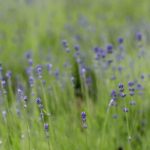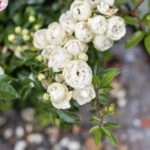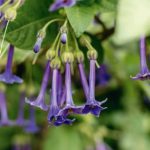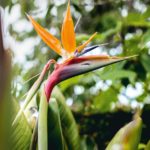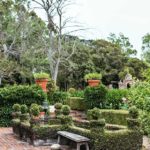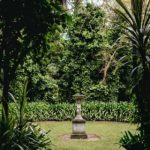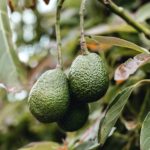The Macfarlane family remember Winterhome garden’s creator
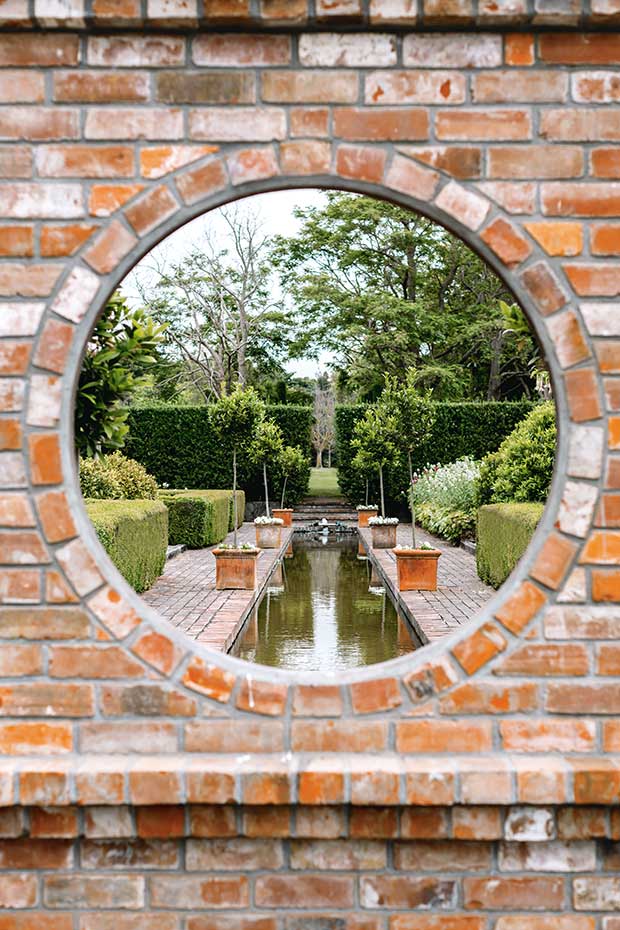
In between many entrepreneurial pursuits, one hardworking, creative woman has left a living legacy – a five-star garden and a close-knit family – and made her mark on her community.
Words: Kate Coughlan Photos: Kate Macpherson
Here lies winterhome spread on grand axes over several hectares high above the hypnotic Pacific Ocean.
That ocean, dramatic as it is, does not distract visitors for long as views through magnificent plantings draw the eye on into this enormous garden so full of intrigue.
Over nearly four decades, on a site south of Blenheim on the coastline near Kekerengu, the creator of Winterhome and her family have established a garden of significant grandeur.
A cyprus walk here, all stern, orderly, standing to attention; a native walk there with softly rounded ngaio trees leading to a formal garden with classical statuary at its centre; a long formal walk edged in buxus, framed by massed plantings and flanked by tall trees leads the eye a very, very long way to a white Lutyens seat.
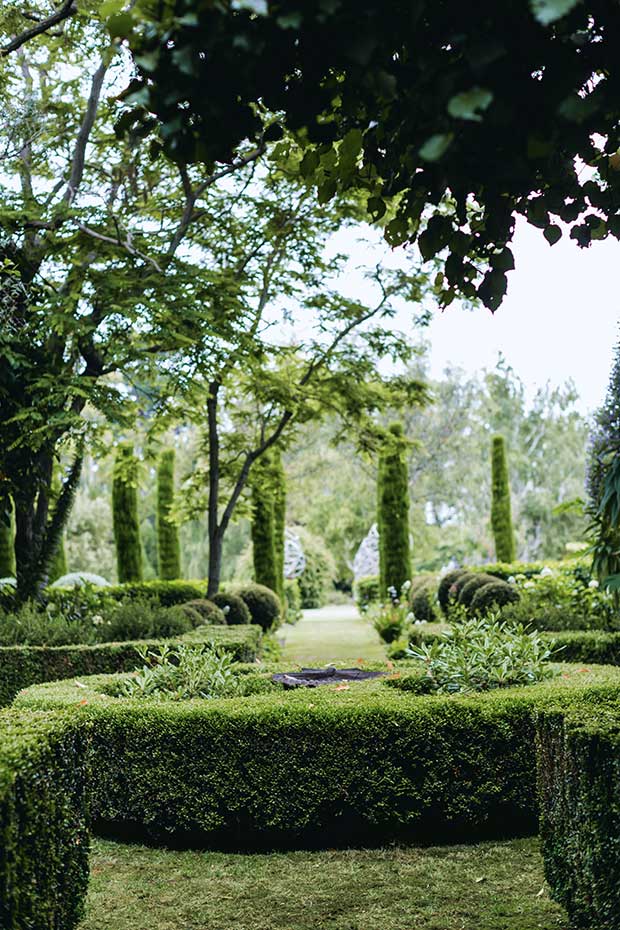
Formal plantings, leading the eye to distant structures, intersect at several places throughout the garden. Circular and straight buxus hedging, low clipped balls, the bound columnar forms of the cyprus walk, and armillary spheres in the distance combine to create mystery and purpose.
In another direction is a parterre, boxing in oranges and limes by the dozen. The formal rose garden, of 80 or so bushes of the repeat-flowering Rosa ‘Margaret Merril’, is a sea of white blooms with peachy-pink centres.
Half a dozen armillary-style spheres, arms wrapped in hemp rope, stand two metres tall and march alongside the entrance drive which, in itself, is a work of art: drive up it and the sky is framed by the akimbo arms of trees in a big, blue orb, drive down it and there’s the sea framed again by those hugging trees in yet another blue burst of light.
A reflection pond, a rill 80 metres long, is enveloped in a walled oblong garden built using 100,000 bricks salvaged from the Zelandia Soap factory at Kaiapoi. A circular keyhole in the imposing wall gives a glimpse of what’s to come.
A suspension bridge leads to the avocado orchard – the southernmost in the country. And still the tour is far from over… Winterhome goes on. It makes the heart sing to visit this garden designed with a courageously big vision.
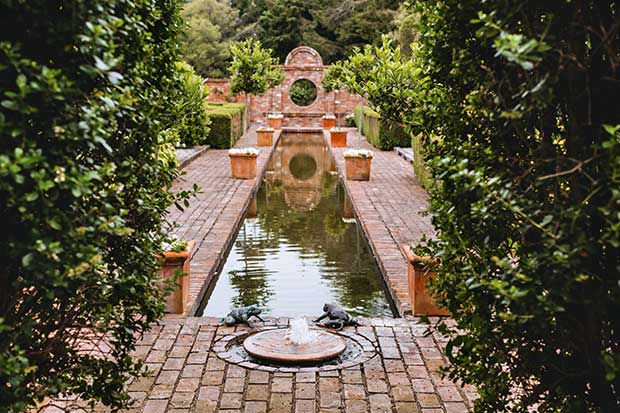
She is missing, the star of this show. The centrepiece of this clan. The creator of the magnificence that is the Winterhome. Very sadly, Sue had not been amid the action of her greatest legacy – the Macfarlane family – for some time.
She’d been not far away, in a home in Blenheim, where she was visited daily by husband Richard and often by her four children. But it had been a long while since she’d known any of them, her dearest…
It doesn’t stop the laughter as the family gathers to tell NZ Life & Leisure about Sue, mother and wife, whose garden is featuring for the 25th year in Rapaura Springs Garden Marlborough in November, but whose garden is by no means the end of her achievements.
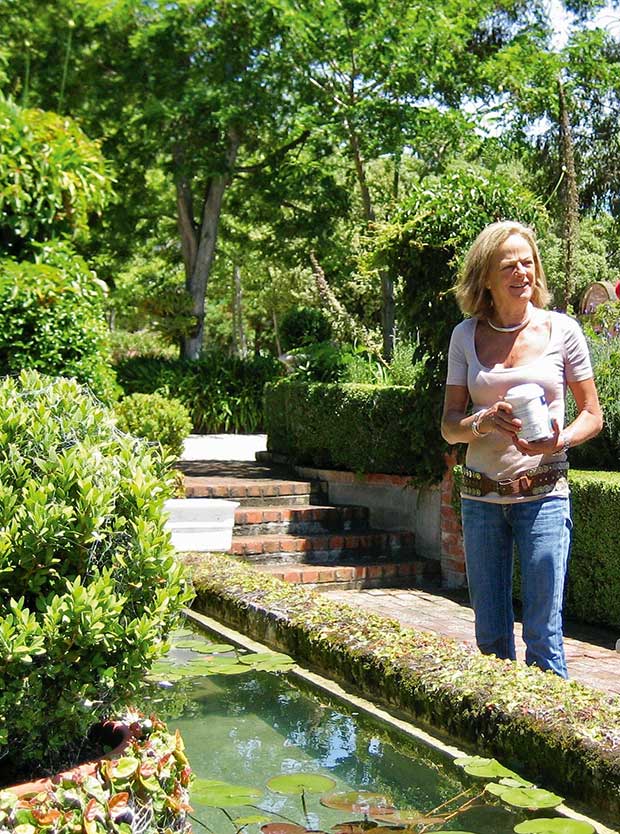
Creator of Winterhome, the hardworking and endlessly creative Sue Macfarlane, who died early in June, is proudly remembered by her family who were pleased this article could pay tribute to her.
“She could do everything,” says her eldest son Sank Macfarlane. Sank now runs The Store at Kekerengu which Sue and Richard opened on Boxing Day 1996 and which has (apart from in the post-quake days) been a roaring success, loved by travelers on the coast road between Blenheim and Kaikoura ever since.
“She was the Bond girl but with a creative brain,” Sank says.
Richard says his wife, Marlborough-born Sue Dillon, grew up among lots of boy cousins, all of whom taught her how to do everything. “This slip of a girl – blonde, strong, courageous and very capable – initially left school for Australia to train polo ponies. She was outdoorsy. She rode very well, could shoot rabbits and drive any sort of vehicle.”
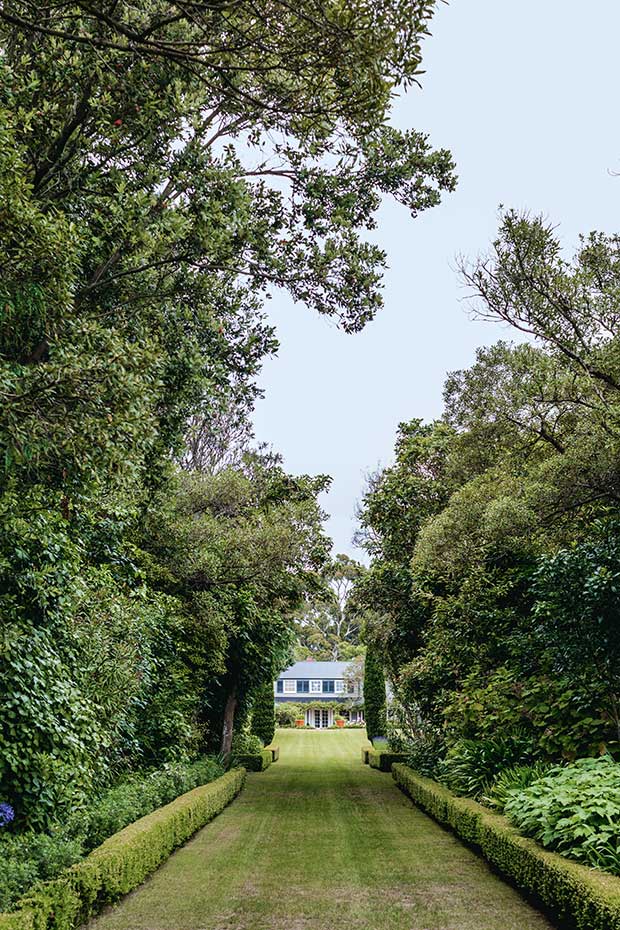
When Sue and Richard arrived at Winterhome in the 1970s, the only garden was to the east of the house. All the magnificent trees, hedges and beds were subsequently planted by Sue, helped often by Richard and their children.
As a mother, say her children, she went a million miles an hour and was always fun. “She was the first one to be pulling mattresses off the beds to create a high-jump pit for us all to practise on,” says Winston recalling a period when his mother hoped her children’s long-limbed Macfarlane genes might result in one of them being a high-jump champion. That was not to be but Winston inherited Sue’s love of yachting and, when he and his wife Niki are not gardening at Winterhome, he is offshore sailing.
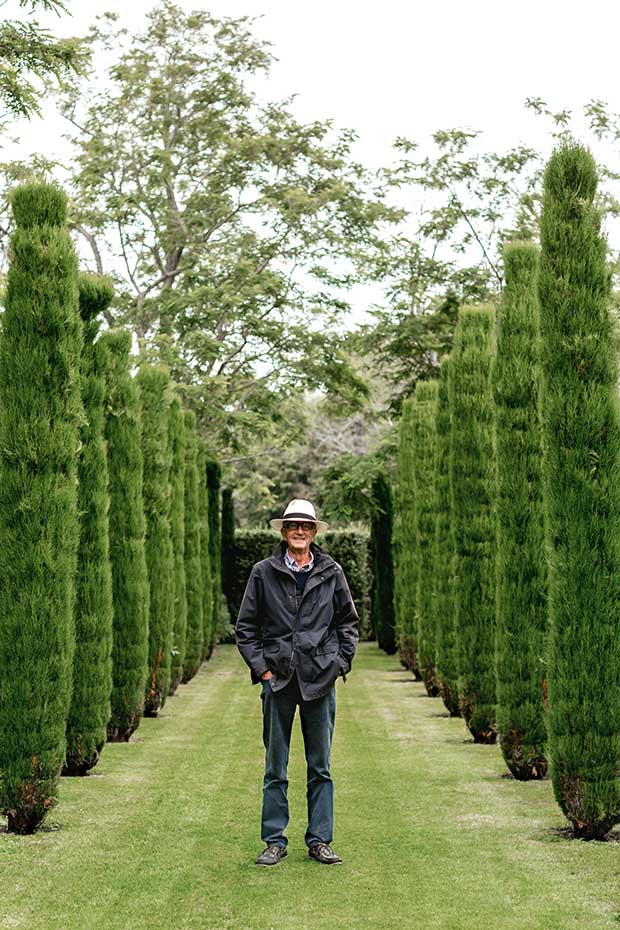
Richard, Sue’s husband, is one of the three original founders of Garden Marlborough. It was his job, on the farm tractor, and often towing a set of harrows, to implement Sue’s latest extension – always on a nice, strong, straight line. He can’t recall the year the cyprus walk was planted.
“Or challenging us all to a sprinting race down the main lawn,” adds Clive, who worked for a decade with Sue at Winterhome and along with his wife, Lizzie, own Wino’s a quality wine retailer in Blenheim, as well as a new Marlborough craft beer company called Boom Town Brewing Co.
The couple are developing their own property in the Hawkesbury Valley.
“Anything Mum threw herself into, she was the best at and went at it with 100-percent commitment,” says her only daughter Alex (an event manager and mother of four-month-old Storm) who was a willing conspirator in many of Sue’s fashion businesses.
“Remember the Diane Freis days?” Alex asks her brothers and pitches NZ Life & Leisure right back in time to the 1980s. Diane Freis? Why yes, of course. She was queen of the multi-coloured print dresses in polyester georgette so loved by the higher-income, more mature women of the day in search of a glamorous and feminine look.
“Oh, those dresses,” recalls Richard defending Sue’s entrepreneurial ability against the hilarity among his children at this recollection. “Sue saw the fashion for these Diane Freis-style dresses and she ordered bolts and bolts of the pre-pleated fabric. God knows where she found it.
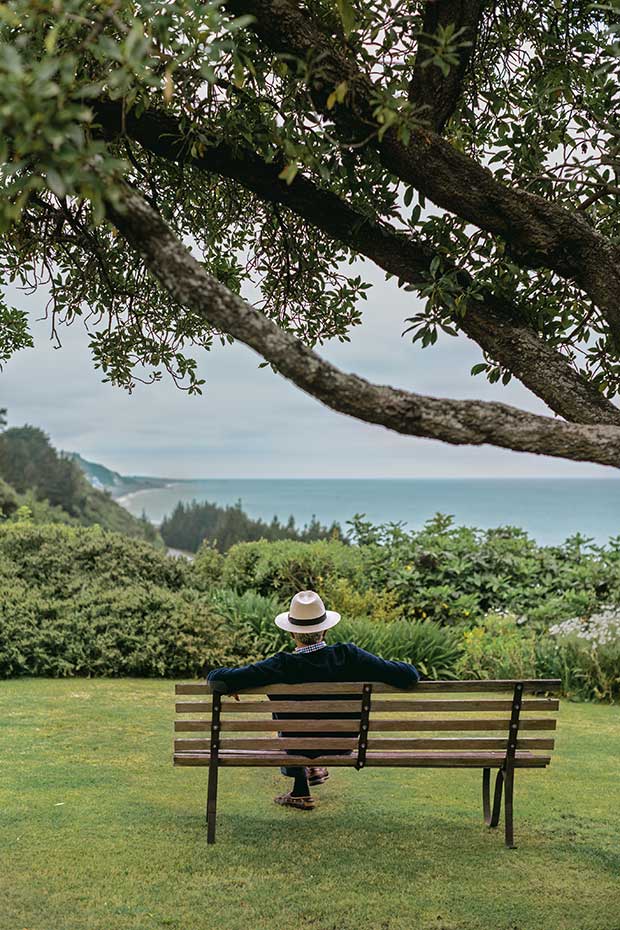
The main lawn, above the formal rose gardens, leads to the thrice-moved Lutyens seat.
Then she bought two overlockers and a sewing machine, rustled up some local ladies, and they went at it. She went to town a few weeks later with a suitcase stuffed full of (fortuitously uncrushable) Diane Freis-style garments.
“A friend in Christchurch introduced her to Margaret Quinn, of the famous Quinns fashion retailer in Merivale. Well, by three that afternoon the entire front window of Quinns was full of Sue’s dresses. And they sold.”
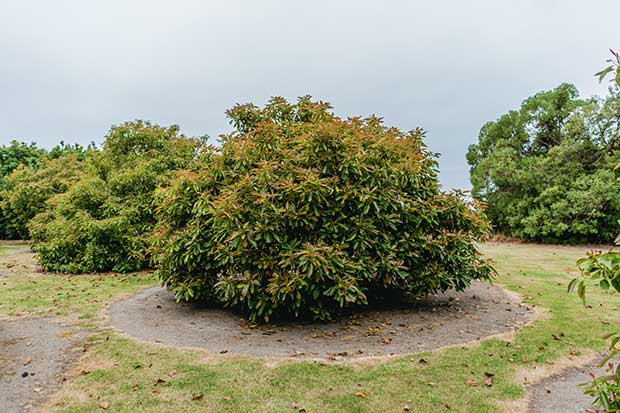
The 25-year-old avocado orchard is the country’s southernmost.
“She made so many Freis dresses, it’s a wonder they aren’t still around,” says Alex. “Do you remember those nightie things? What about them?” asks one of the boys about another fashion-inspired innovation of their mother.
“Ah,” recalls Alex, “the djellaba era.” Yes, Sue had another busy and productive period introducing this garment, traditional to the women of the Atlas Mountains in North Africa, to the women of Canterbury and Marlborough.
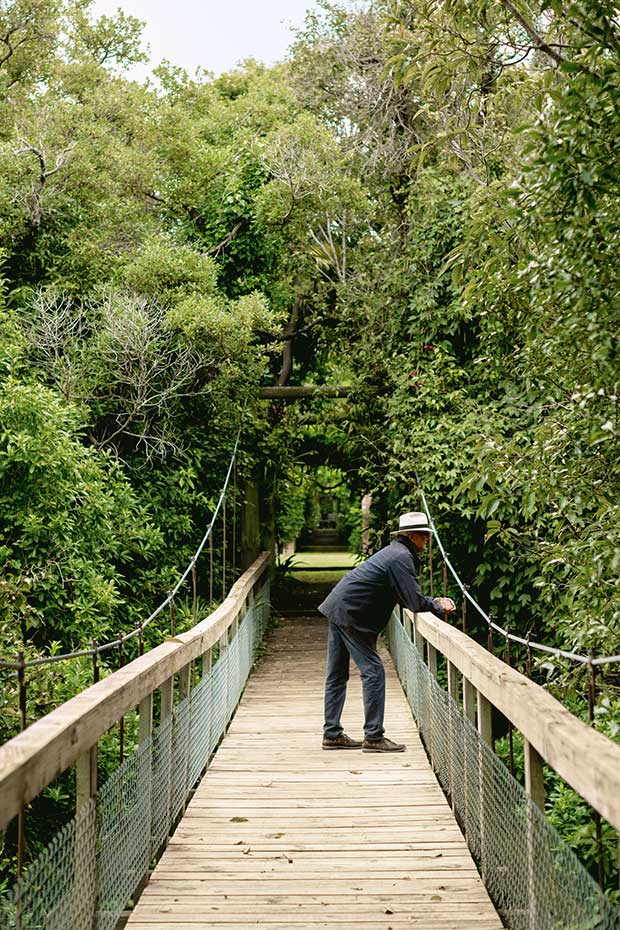
The suspension bridge footing took Winston days to dig.
The loose-fitting, unisex robe was sold as useful night attire. Alex loves it that she’s seen her mother’s djellabas worn in many smart places including the races.
Then came the skivvy period. “She made the skivvy cool,” reckons Clive.
“Where did she get the fabric from?” wonders Alex of the pre-internet age in which her mother seemed to be able to pick up on international trends, feeling the vibe from her home above Kekerengu on the Kaikoura coast.
- Formal topiary surrounds a fish pond near the walled garden and reflection rill
- The native walk ends with this classical feature.
- The avocados are intensely flavoured and sought-after.
- Orlo, Winston and Niki’s son, loves his life as Winterhome’s latest resident toddler.
“How did she do that? The fabric was like Lycra, with a four-way stretch, but she was using it way before Lycra was introduced.”
“The four-way stretch,” laugh the boys, “that was the selling point, the four-way stretch.”
No recollection gets the Macfarlane clan erupting in more joyous laughter than the era of the copper plant tags. At this stage, Sue had opened Winterhome to the public and was selling horticultural bits and pieces.
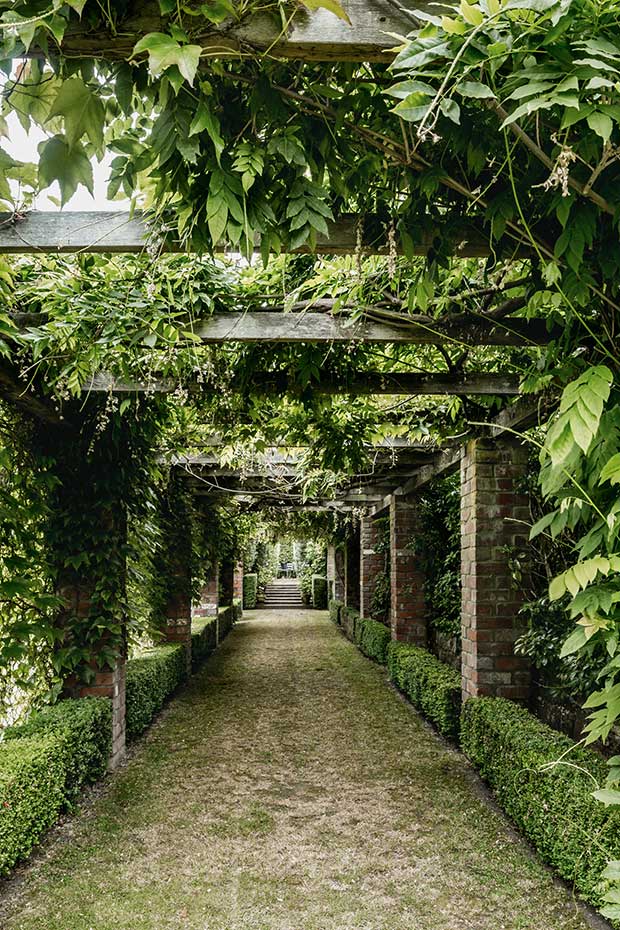
Sue delighted in taking the eye off to distant destinations, and was never scared of making big, bold moves.
“So,” they start in unison, “she got this idea of selling plant tags made from copper. There we all were, at the dining table, each of us with a job.
She’d borrowed the guillotine from the local Ward Primary School and one of us was guillotining large sheets of copper into the required lengths and then cross-cutting to the tag size.
A couple of us were on the nail scissors trimming the edges of each tag into nice rounded corners, another was on the hole punch putting in a hole for the tie and someone else was counting them into packs of 100.”
“Oh well,” says Richard, “there were a lot of you to send to boarding school and the days of sheep and beef farms providing revenue for that were long gone.”
Similarly, the family worked as a unit in the garden.
Often Sue had a big project on: when she got planting it tended to be by the dozen, when she moved the Lutyens bench further west it went back hundreds of metres and when she decided to put in the avocado orchard, she determined access should be via a suspension bridge swooping above the dramatic entrance drive.
Winston, suspended from boarding school at the time (for what reason he cannot recall), was delegated to dig the footings for the bridge.
“There was a lot of digging,” he says. “I dug for days.”
“That’s just what we did as a family,” says Richard.
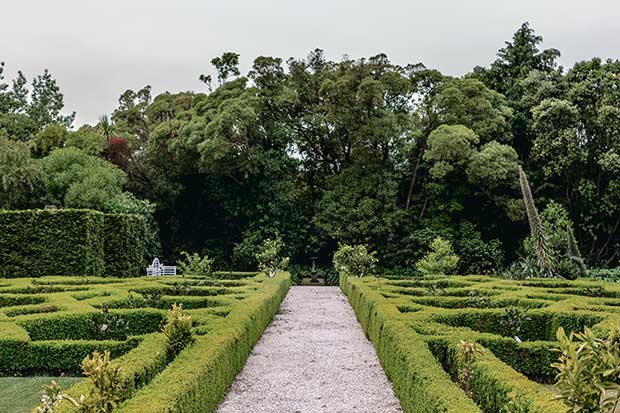
Formal citrus beds were recently replanted with new orange and lime trees. Sue used to beautify the trunks of her citrus with limewash but tired of having to renew it each year and used Dulux roof paint which, say her family, was just as good but lasted a lot longer.
Sue and Richard left their first farm in South Otago (Richard’s home province) in the 1970s and bought Sue’s grandparents’ farm, Winterhome. Her grandfather, Commander Sandford Critchley (a naval officer with Canadian origins), and grandmother, discovered the frost-free nature of the site and developed their garden with subtropical plants.
That garden, on the east side of the house, remains very much how it was in Sue’s grandmother’s day – a legacy which Sue, despite not liking bright subtropical colours, felt unable to change.
She had no such qualms about developing a garden on the west (sunny) side of the property. First she ordered an aerial photograph of the house and surrounding paddocks, then sat at the kitchen table with a ruler and drew strong, decisive lines through the fields and across driveways.
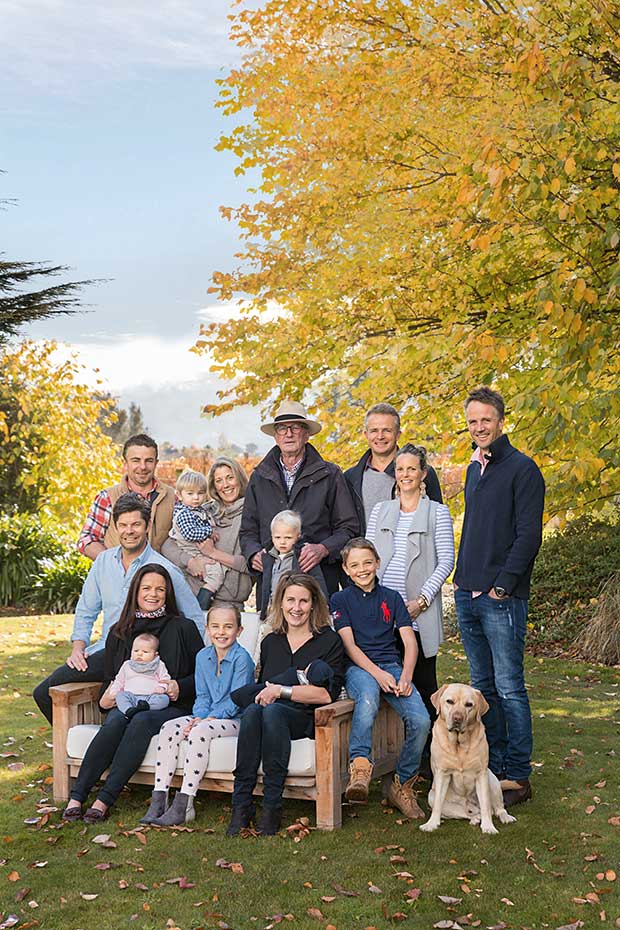
Sue’s greatest creation – her family. Back row from left: Clive, Lizzie and two-year-old Woody, Richard holding two-year-old Orlo, Winston, Niki and Sank. Seated in front row from left: Mike, Alex and four-month-old Storm on her knee, Gussy, Melissa (holding six-week-old Huck), Rocky and Scotch the dog.
Richard, with the farm tractor and a set of harrows, began implementing the vision. As with many of this country’s large gardens, it continued to expand every decade or so. The driveway has been shifted three times, and each time it was to create a bolder, stronger garden.
Richard isn’t sure where Sue’s design ideas came from. “She was a Dillon, and they all have a creative strength. But we didn’t consciously go on garden tours abroad. We might visit a garden if we were near a world-famous one but she didn’t come home and set about creating something she’d seen.”
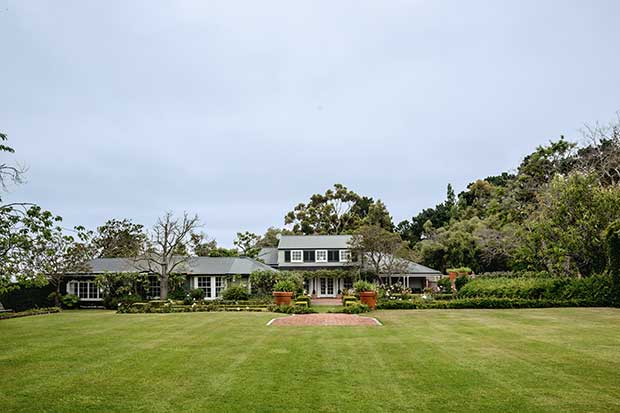
The homestead has been twice altered: first in Sue’s grandparents’ days to a design by renowned Canterbury architect Heathcote Helmore; secondly, in Richard and Sue’s time, by another famous Canterbury architect, Sir Miles Warren who added the top storey and extended the living space for the fast-growing Macfarlane clan.
He believes the long pond, and surrounding oblong walled garden was inspired, in part, by the courtyard in the Alhambra gardens, Granada. They visited once when they were very young and it must have stuck in her mind. Her development of an avocado orchard was driven by a government scheme to support diversification.
Thus began another Macfarlane family venture. “She taught us all how to graft,” recalls Clive, saying that Sue had good rootstock and bought trees from a Katikati orchard but wanted more. So the family set about grafting 100 avocados (of which 60 remain), providing what they describe as the most delicious avocado they have ever tasted.
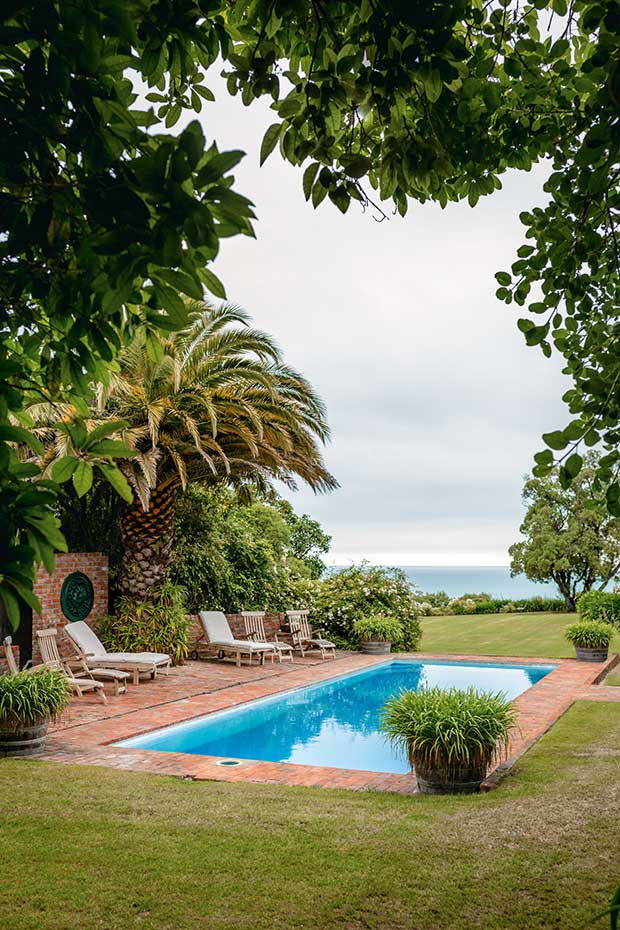
Boldly coloured subtropical plantings on the east side of the garden surrounding the pool date back to Sue’s grandmother’s time. Although they weren’t really to Sue’s liking she couldn’t bring herself to replace them. The black circle in the centre of the brick wall is a plaster ceiling rose painted black. One of Sue’s many entrepreneurial schemes involved saving ceiling roses from demolition yards, painting them and reselling them.
“That was typical of Mum,” he says. “She wanted to make everything the best she could and wasn’t scared of trying things. And then teaching us all how to do it.”
Today Winterhome is tended by Winston and his wife Niki and is home to toddler Orlo. All the family feel comfortable knowing how to maintain the garden, raised as they were with their mother’s strong design ideals ringing in their ears: be bold, make it straight, no fussy planting, hedges, edges and lawns to be kept perfectly.
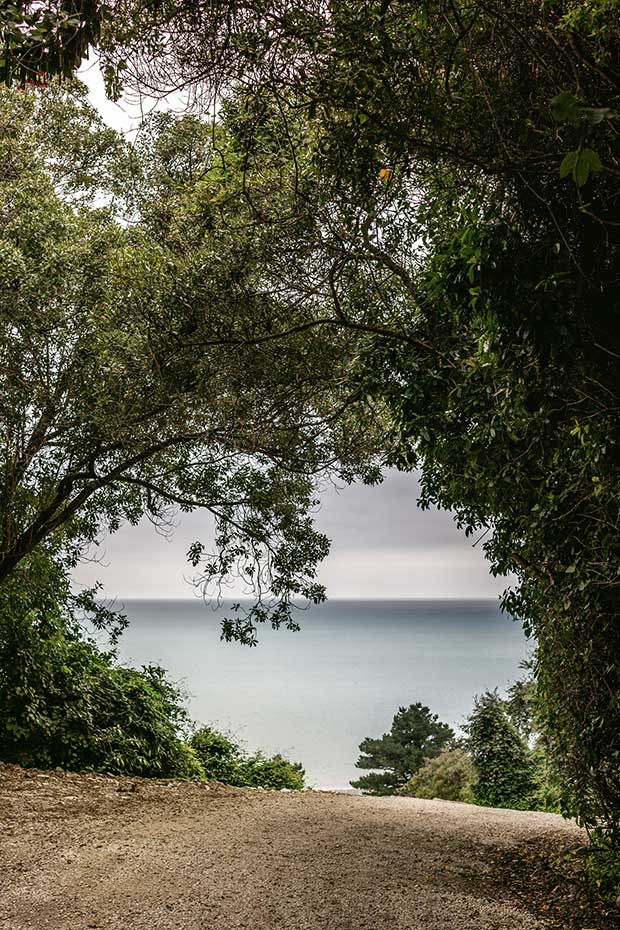
The drive, relocated three times, is flanked by trees which frame the open sky on arrival and the distant ocean on departure.
And they are all involved in its care.
“We’re a tight unit,” says Richard of his family, “and I guess that comes about because of how we’ve always worked together.”
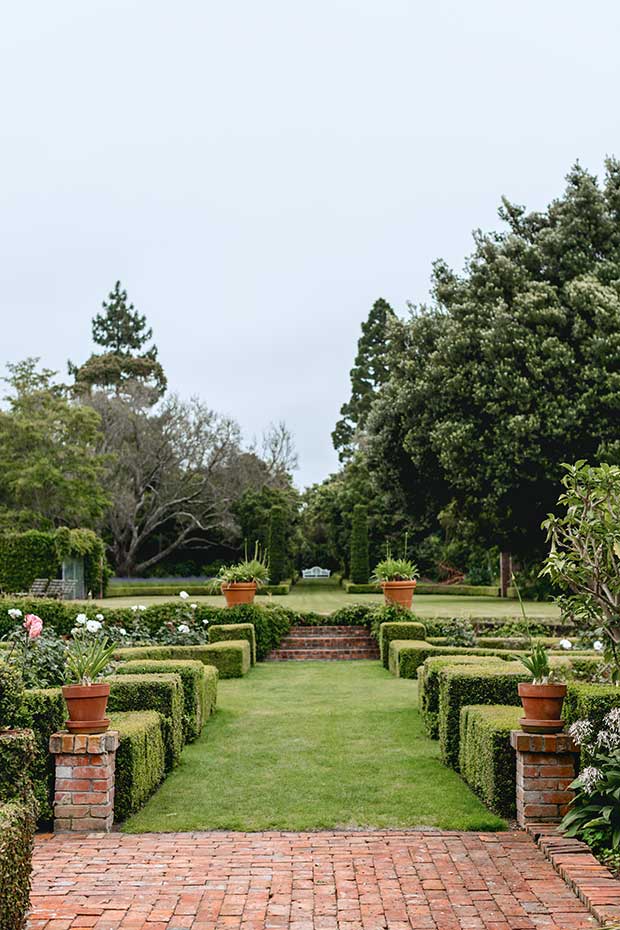
The main lawn, above the formal rose gardens, leads to the thrice-moved Lutyens seat.
‘Winterhome is a dramatic garden designed with a masterful hand, taking the eye from the vast Pacific Ocean to vistas of equal scale and simple magnificence. What a vision Sue had, boldly creating a garden bisected with several powerful axes leading through massed plantings to formal areas resulting in a uniquely European feel’ – Bev McConnell, creator of Ayrlies, instigator and original assessor for the NZ Gardens Trust.
WIN A VISIT TO WINTERHOME
Winterhome is part of the Garden Marlborough Festival, 8-11 November 2018, sponsored by Rapaura Springs. Garden Marlborough was started by Richard Macfarlane and three others 25 years ago and is today the country’s premiere garden festival. Visit gardenmarlborough.co.nz to order tickets or be in to win an all-inclusive weekend –
https://thisnzlife.co.nz/be-in-to-win-an-all-inclusive-weekend-for-two-at-garden-marlborough-valued-at-1600/
MORE GARDEN MARLBOROUGH STORIES
What Carolyn Ferraby learned creating Barewood Garden in Marlborough
What Carolyn Ferraby learned creating Barewood Garden in Marlborough
Love this story? Subscribe now!
 This article first appeared in NZ Life & Leisure Magazine.
This article first appeared in NZ Life & Leisure Magazine.

